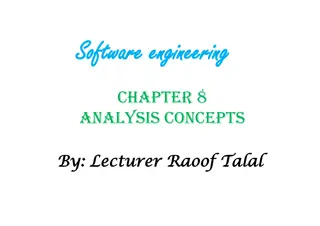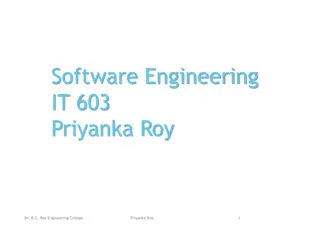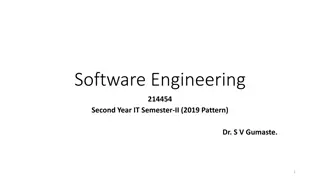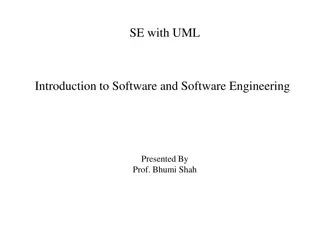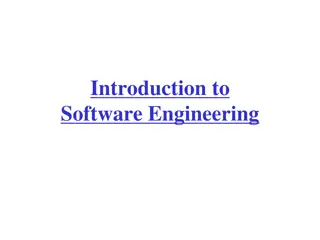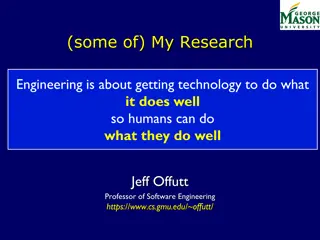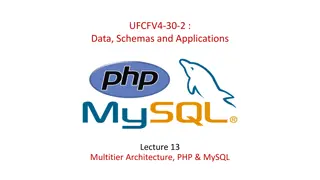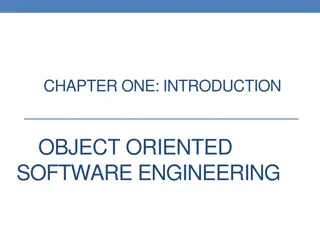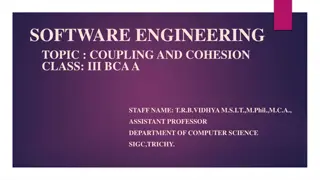Software Engineering and Architecture Overview
This course covers topics in software engineering and architecture, including architectural design, system decomposition, distribution architecture, agile methods, cloud-based software, RESTful services, DevOps, testing, and project management. The syllabus includes a range of subjects related to software development processes and practices. The course is taught by Associate Professor Min-Yuh Day at the National Taipei University.
Download Presentation

Please find below an Image/Link to download the presentation.
The content on the website is provided AS IS for your information and personal use only. It may not be sold, licensed, or shared on other websites without obtaining consent from the author.If you encounter any issues during the download, it is possible that the publisher has removed the file from their server.
You are allowed to download the files provided on this website for personal or commercial use, subject to the condition that they are used lawfully. All files are the property of their respective owners.
The content on the website is provided AS IS for your information and personal use only. It may not be sold, licensed, or shared on other websites without obtaining consent from the author.
E N D
Presentation Transcript
(Software Engineering) (Software Architecture: Architectural design, System decomposition, and Distribution architecture) 1091SE05 MBA, IM, NTPU (M5118) (Fall 2020) Tue 2, 3, 4 (9:10-12:00) (B8F40) Min-Yuh Day Associate Professor Institute of Information Management, National Taipei University https://web.ntpu.edu.tw/~myday 2020-10-13 1
(Syllabus) (Week) (Date) (Subject/Topics) 1 2020/09/15 (Introduction to Software Engineering) 2 2020/09/22 (Software Products and Project Management: Software product management and prototyping) 3 2020/09/29 Scrum (Agile Software Engineering: Agile methods, Scrum, and Extreme Programming) 4 2020/10/06 (Features, Scenarios, and Stories) 5 2020/10/13 (Software Architecture: Architectural design, System decomposition, and Distribution architecture) 6 2020/10/20 I (Case Study on Software Engineering I) 2
(Syllabus) (Week) (Date) (Subject/Topics) 7 2020/10/27 (Cloud-Based Software: Virtualization and containers, Everything as a service, Software as a service) 8 2020/11/03 (Cloud Computing and Cloud Software Architecture) 9 2020/11/10 (Midterm Project Report) 10 2020/11/17 RESTful (Microservices Architecture, RESTful services, Service deployment) 11 2020/11/24 (Industry Practices of Software Engineering) 12 2020/12/01 (Security and Privacy) 3
(Syllabus) (Week) (Date) (Subject/Topics) 13 2020/12/08 II (Case Study on Software Engineering II) 14 2020/12/15 (Reliable Programming) 15 2020/12/22 (Testing: Functional testing, Test automation, Test-driven development, and Code reviews) 16 2020/12/29 DevOps DevOps (DevOps and Code Management: Code management and DevOps automation) 17 2021/01/05 I (Final Project Report I) 18 2021/01/12 II (Final Project Report I) 4
Software Engineering and Project Management Design Test Deliver Build Analyze System and Software design Integration and system testing Operation and maintenance Implementation and unit testing Requirements definition Project Management 5
Product management concerns Business needs Product manager Technology constraints Customer experience 6 Source: Ian Sommerville (2019), Engineering Software Products: An Introduction to Modern Software Engineering, Pearson.
Technical interactions of product managers Product vision management Product backlog management User stories and scenarios Product manager Acceptance testing Customer testing User interface design 7 Source: Ian Sommerville (2019), Engineering Software Products: An Introduction to Modern Software Engineering, Pearson.
Software Development Life Cycle (SDLC) The waterfall model Requirements definition System and Software design Implementation and unit testing Integration and system testing Operation and maintenance 8 Source: Ian Sommerville (2015), Software Engineering, 10th Edition, Pearson.
Plan-based and Agile development Plan-based development Requirements engineering Requirements specification Design and implementation Requirements change requests Agile development Requirements engineering Design and implementation 9 Source: Ian Sommerville (2015), Software Engineering, 10th Edition, Pearson.
The Continuum of Life Cycles High Incremental Agile Frequency of Delivery Predictive Iterative Low Low High Degree of Change 10 Source: Project Management Institute (2017), Agile Practice Guide, Project Management Institute
Predictive Life Cycle Analyze Design Build Test Deliver 11 Source: Project Management Institute (2017), Agile Practice Guide, Project Management Institute
Iterative Life Cycle Refine Prototype Analyze Design Build Test Analyze Deliver 12 Source: Project Management Institute (2017), Agile Practice Guide, Project Management Institute
A Life Cycle of Varying-Sized Increments Analyze Design Build Test Deliver Analyze Design Build Test Deliver Analyze Design Build Test Deliver 13 Source: Project Management Institute (2017), Agile Practice Guide, Project Management Institute
Iteration-Based and Flow-Based Agile Life Cycles Iteration-Based Agile Requirements Analysis Design Build Test Requirements Analysis Design Build Test Requirements Analysis Design Build Test Requirements Analysis Design Build Test Requirements Analysis Design Build Test Requirements Analysis Design Build Test Repeat as needed Flow-Based Agile Requirements Analysis Design Build Test the number of features in the WIP limit Requirements Analysis Design Build Test the number of features in the WIP limit Requirements Analysis Design Build Test the number of features in the WIP limit Requirements Analysis Design Build Test the number of features in the WIP limit Requirements Analysis Design Build Test the number of features in the WIP limit Repeat as needed 14 Source: Project Management Institute (2017), Agile Practice Guide, Project Management Institute
From personas to features 1 Personas A way of representing users inspire Natural language descriptions of a user interacting with a software product are-developed-into Scenarios 2 3 Natural language descriptions of something that is needed or wanted by users inspire Stories 4 Features define Fragments of product functionality 15 Source: Ian Sommerville (2019), Engineering Software Products: An Introduction to Modern Software Engineering, Pearson.
Software Architecture: Architectural design, System decomposition, and Distribution architecture 16
Software architecture To create a reliable, secure and efficient product, you need to pay attention to architectural design which includes: its overall organization, how the software is decomposed into components, the server organization the technologies that you use to build the software. The architecture of a software product affects its performance, usability, security, reliability and maintainability. 17 Source: Ian Sommerville (2019), Engineering Software Products: An Introduction to Modern Software Engineering, Pearson.
Software architecture There are many different interpretations of the term software architecture . Some focus on architecture as a noun - the structure of a system and others consider architecture to be a verb - the process of defining these structures. 18 Source: Ian Sommerville (2019), Engineering Software Products: An Introduction to Modern Software Engineering, Pearson.
The IEEE definition of software architecture Architecture is the fundamental organization of a software system embodied in its components, their relationships to each other and to the environment, and the principles guiding its design and evolution. 19 Source: Ian Sommerville (2019), Engineering Software Products: An Introduction to Modern Software Engineering, Pearson.
Software architecture and components A component is an element that implements a coherent set of functionality or features. Software component can be considered as a collection of one or more services that may be used by other components. When designing software architecture, you don t have to decide how an architectural element or component is to be implemented. Rather, you design the component interface and leave the implementation of that interface to a later stage of the development process. 20 Source: Ian Sommerville (2019), Engineering Software Products: An Introduction to Modern Software Engineering, Pearson.
Access to services provided by software components Services accessed through the component API Services accessed directly by other components API S3 S6 S2 S5 S1 S4 Component 2 Component 1 21 Source: Ian Sommerville (2019), Engineering Software Products: An Introduction to Modern Software Engineering, Pearson.
Why is architecture important? Architecture is important because the architecture of a system has a fundamental influence on the non- functional system properties. Architectural design involves understanding the issues that affect the architecture of your product and creating an architectural description that shows the critical components and their relationships. Minimizing complexity should be an important goal for architectural designers. 22 Source: Ian Sommerville (2019), Engineering Software Products: An Introduction to Modern Software Engineering, Pearson.
Non-functional system quality attributes Responsiveness Does the system return results to users in a reasonable time? Reliability Do the system features behave as expected by both developers and users? Availability Can the system deliver its services when requested by users? Security Does the system protect itself and users data from unauthorized attacks and intrusions? 23 Source: Ian Sommerville (2019), Engineering Software Products: An Introduction to Modern Software Engineering, Pearson.
Non-functional system quality attributes Usability Can system users access the features that they need and use them quickly and without errors? Maintainability Can the system be readily updated and new features added without undue costs? Resilience Can the system continue to deliver user services in the event of partial failure or external attack? 24 Source: Ian Sommerville (2019), Engineering Software Products: An Introduction to Modern Software Engineering, Pearson.
Centralized security architectures The benefits of a centralized security architecture are that it is easier to design and build protection and that the protected information can be accessed more efficiently. However, if your security is breached, you lose everything. If you distribute information, it takes longer to access all of the information and costs more to protect it. If security is breached in one location, you only lose the information that you have stored there. 25 Source: Ian Sommerville (2019), Engineering Software Products: An Introduction to Modern Software Engineering, Pearson.
Shared database architecture User interface C1 C2 Shared database 26 Source: Ian Sommerville (2019), Engineering Software Products: An Introduction to Modern Software Engineering, Pearson.
Multiple database architecture User interface C1 C2 C1 database C2 database C3 Database reconciliation 27 Source: Ian Sommerville (2019), Engineering Software Products: An Introduction to Modern Software Engineering, Pearson.
Maintainability and performance Shared database architecture: system with two components (C1 and C2) that share a common database. Multiple database architecture: each component has its own copy of the parts of the database that it needs. If one component needs to change the database organization, this does not affect the other component. A multi-database architecture may run more slowly and may cost more to implement and change. A multi-database architecture needs a mechanism (component C3) to ensure that the data shared by C1 and C2 is kept consistent when it is changed. 28 Source: Ian Sommerville (2019), Engineering Software Products: An Introduction to Modern Software Engineering, Pearson.
Issues that influence architectural decisions Nonfunctional product characteristics Software compatibility Product lifetime Architectural influences Number of users Software reuse 29 Source: Ian Sommerville (2019), Engineering Software Products: An Introduction to Modern Software Engineering, Pearson.
The importance of architectural design issues Nonfunctional product characteristics Nonfunctional product characteristics such as security and performance affect all users. If you get these wrong, your product will is unlikely to be a commercial success. Unfortunately, some characteristics are opposing, so you can only optimize the most important. Product lifetime If you anticipate a long product lifetime, you will need to create regular product revisions. You therefore need an architecture that is evolvable, so that it can be adapted to accommodate new features and technology. Software reuse You can save a lot of time and effort, if you can reuse large components from other products or open-source software. However, this constrains your architectural choices because you must fit your design around the software that is being reused. 30 Source: Ian Sommerville (2019), Engineering Software Products: An Introduction to Modern Software Engineering, Pearson.
The importance of architectural design issues Number of users If you are developing consumer software delivered over the Internet, the number of users can change very quickly. This can lead to serious performance degradation unless you design your architecture so that your system can be quickly scaled up and down. Software compatibility For some products, it is important to maintain compatibility with other software so that users can adopt your product and use data prepared using a different system. This may limit architectural choices, such as the database software that you can use. 31 Source: Ian Sommerville (2019), Engineering Software Products: An Introduction to Modern Software Engineering, Pearson.
Trade off: Maintainability vs performance System maintainability is an attribute that reflects how difficult and expensive it is to make changes to a system after it has been released to customers. You improve maintainability by building a system from small self-contained parts, each of which can be replaced or enhanced if changes are required. In architectural terms, this means that the system should be decomposed into fine-grain components, each of which does one thing and one thing only. However, it takes time for components to communicate with each other. Consequently, if many components are involved in implementing a product feature, the software will be slower. Source: Ian Sommerville (2019), Engineering Software Products: An Introduction to Modern Software Engineering, Pearson. 32
Trade off: Security vs usability You can achieve security by designing the system protection as a series of layers. An attacker has to penetrate all of those layers before the system is compromised. Layers might include system authentication layers, a separate critical feature authentication layer, an encryption layer and so on. Architecturally, you can implement each of these layers as separate components so that if one of these components is compromised by an attacker, then the other layers remain intact. 33 Source: Ian Sommerville (2019), Engineering Software Products: An Introduction to Modern Software Engineering, Pearson.
Authentication layers IP authentication Application authentication Feature authentication Encryption Protect asset such as a database of user s credit card 34 Source: Ian Sommerville (2019), Engineering Software Products: An Introduction to Modern Software Engineering, Pearson.
Usability issues A layered approach to security affects the usability of the software. Users have to remember information, like passwords, that is needed to penetrate a security layer. Their interaction with the system is inevitably slowed down by its security features. Many users find this irritating and often look for work-arounds so that they do not have to re-authenticate to access system features or data. To avoid this, you need an architecture: that doesn t have too many security layers that doesn t enforce unnecessary security that provides helper components that reduce the load on users 35 Source: Ian Sommerville (2019), Engineering Software Products: An Introduction to Modern Software Engineering, Pearson.
An architectural model of a document retrieval system Local input validation Web browser Local printing User interaction User interface management Authentication and authorization Form and query manager Web page generation Information retrieval Document retrieval Rights Search Payments Accounting management Index Index querying Index creation Document index management Query validation User account management Database Query Logging Basic services Databases DB1 DB2 DB3 DB4 DB5 36 Source: Ian Sommerville (2019), Engineering Software Products: An Introduction to Modern Software Engineering, Pearson.
Examples of component relationships C1 uses C2 C1 is part of C2 C1 C2 calls C1 C2 C1 is-located-with C2 C1 shared-data-with C2 C1 C2 Data C1 C2 37 Source: Ian Sommerville (2019), Engineering Software Products: An Introduction to Modern Software Engineering, Pearson.
Architectural design guidelines Separation of concerns Organize your architecture into components that focus on a single concern Design guidelines Stable interfaces Design component interfaces that are coherent and that changes slowly Implement once Avoid duplicating functionality at different places in your architecture 38 Source: Ian Sommerville (2019), Engineering Software Products: An Introduction to Modern Software Engineering, Pearson.
Cross-cutting concerns Security Performance Reliability User interface Application Infrastructure Operating System Hardware 39 Source: Ian Sommerville (2019), Engineering Software Products: An Introduction to Modern Software Engineering, Pearson.
A generic layered architecture for a web-based application Browser-based or mobile user interface Authentication and user interaction management Application-specific functionality Basic shared services Transaction and database management 40 Source: Ian Sommerville (2019), Engineering Software Products: An Introduction to Modern Software Engineering, Pearson.
A layered architectural model of the iLearn system User interface iLearn app Web browser User interface management Forms management Interface creation Interface delivery Login Configuration services Group Application configuration Security configuration User interface configuration Setup service configuration Application services Archive access Word processor Video conf. Blog Wiki Spreadsheet Presentation Drawing User installed application Email and messaging Integrated services User analytics Resource discovery Virtual Learning environment Authentication and authorization Shared infrastructure services Authentication Logging and monitoring Application interfacing User storage Application storage Search 41 Source: Ian Sommerville (2019), Engineering Software Products: An Introduction to Modern Software Engineering, Pearson.
Distribution architecture The distribution architecture of a software system defines the servers in the system and the allocation of components to these servers. Client-server architectures are a type of distribution architecture that is suited to applications where clients access a shared database and business logic operations on that data. In this architecture, the user interface is implemented on the user s own computer or mobile device. Functionality is distributed between the client and one or more server computers. 42 Source: Ian Sommerville (2019), Engineering Software Products: An Introduction to Modern Software Engineering, Pearson.
Client-server architecture Client 1 request response request Client 2 response request Client 3 response request Servers Load balancer Client response 43 Source: Ian Sommerville (2019), Engineering Software Products: An Introduction to Modern Software Engineering, Pearson.
The Model-View-Controller (MVC) pattern Browser CLIENT Page to display User inputs User changes Controller View Change notification View update request View refresh request Model SERVER 44 Source: Ian Sommerville (2019), Engineering Software Products: An Introduction to Modern Software Engineering, Pearson.
Mobile Web App HTML Phone Data Templates JavaScript CSS External Data Mobile frameworks and Libraries 45 Source: Scott Preston, Learn HTML5 and JavaScript for iOS: Web Standards-based Apps for iPhone, iPad, and iPod touch, Apress, 2012
MVC Framework of Mobile Apps (HTML5, CSS3, JavaScript) Source: http://sc5.io/blog/2012/02/anatomy-of-a-html5-app/ 46
Multi-tier client-server architecture Client 1 Client 2 Web Server Application Server Database Server Client 3 Client 47 Source: Ian Sommerville (2019), Engineering Software Products: An Introduction to Modern Software Engineering, Pearson.
Service-oriented Architecture Services in a service-oriented architecture are stateless components, which means that they can be replicated and can migrate from one computer to another. Many servers may be involved in providing services A service-oriented architecture is usually easier to scale as demand increases and is resilient to failure. 48 Source: Ian Sommerville (2019), Engineering Software Products: An Introduction to Modern Software Engineering, Pearson.
Service-oriented Architecture Client 1 S1 S2 Client 2 S3 Web Server Service gateway S4 Client 3 S5 S6 Client Services 49 Source: Ian Sommerville (2019), Engineering Software Products: An Introduction to Modern Software Engineering, Pearson.
Issues in architectural choice Data type and data updates If you are mostly using structured data that may be updated by different system features, it is usually best to have a single shared database that provides locking and transaction management. If data is distributed across services, you need a way to keep it consistent and this adds overhead to your system. Change frequency If you anticipate that system components will be regularly changed or replaced, then isolating these components as separate services simplifies those changes. The system execution platform If you plan to run your system on the cloud with users accessing it over the Internet, it is usually best to implement it as a service-oriented architecture because scaling the system is simpler. If your product is a business system that runs on local servers, a multi-tier architecture may be more appropriate. 50 Source: Ian Sommerville (2019), Engineering Software Products: An Introduction to Modern Software Engineering, Pearson.




